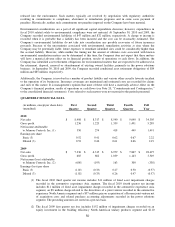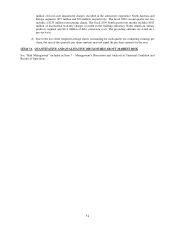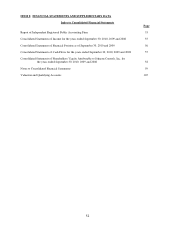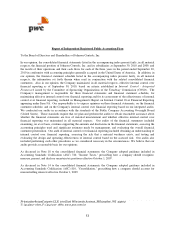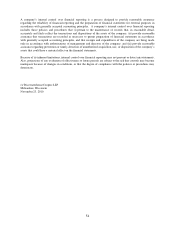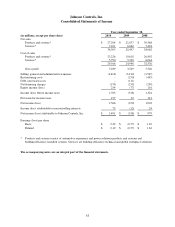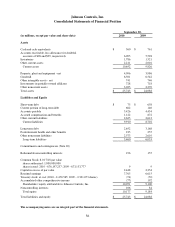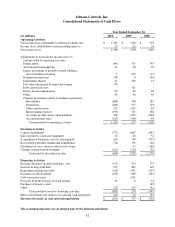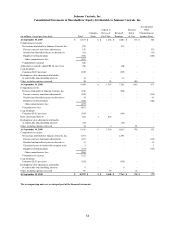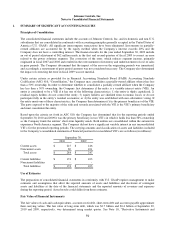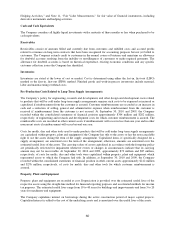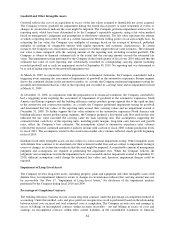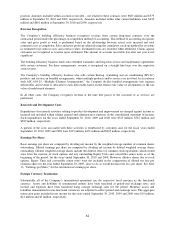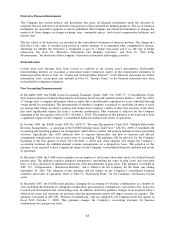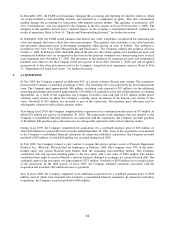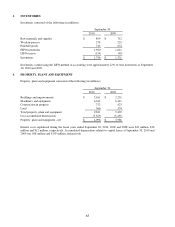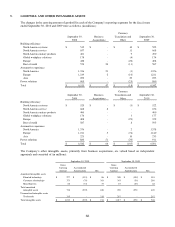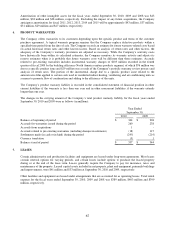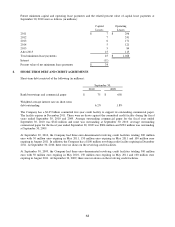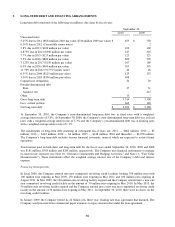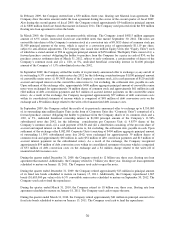Johnson Controls 2010 Annual Report Download - page 60
Download and view the complete annual report
Please find page 60 of the 2010 Johnson Controls annual report below. You can navigate through the pages in the report by either clicking on the pages listed below, or by using the keyword search tool below to find specific information within the annual report.60
Hedging Activities,‖ and Note 11, ―Fair Value Measurements,‖ for fair value of financial instruments, including
derivative instruments and hedging activities.
Cash and Cash Equivalents
The Company considers all highly liquid investments with a maturity of three months or less when purchased to be
cash equivalents.
Receivables
Receivables consist of amounts billed and currently due from customers and unbilled costs and accrued profits
related to revenues on long-term contracts that have been recognized for accounting purposes but not yet billed to
customers. The Company extends credit to customers in the normal course of business and maintains an allowance
for doubtful accounts resulting from the inability or unwillingness of customers to make required payments. The
allowance for doubtful accounts is based on historical experience, existing economic conditions and any specific
customer collection issues the Company has identified.
Inventories
Inventories are stated at the lower of cost or market. Cost is determined using either the last-in, first-out (LIFO)
method or the first-in, first-out (FIFO) method. Finished goods and work-in-process inventories include material,
labor and manufacturing overhead costs.
Pre-Production Costs Related to Long-Term Supply Arrangements
The Company’s policy for engineering, research and development, and other design and development costs related
to products that will be sold under long-term supply arrangements requires such costs to be expensed as incurred or
capitalized if reimbursement from the customer is assured. Customer reimbursements are recorded as an increase in
cash and a reduction of selling, general and administrative expense when reimbursement from the customer is
received if reimbursement from the customer is not assured. At September 30, 2010 and 2009, the Company
recorded within the consolidated statements of financial position approximately $304 million and $282 million,
respectively, of engineering and research and development costs for which customer reimbursement is assured. The
reimbursable costs are recorded in other current assets if reimbursement will occur in less than one year and in other
noncurrent assets if reimbursement will occur beyond one year.
Costs for molds, dies and other tools used to make products that will be sold under long-term supply arrangements
are capitalized within property, plant and equipment if the Company has title to the assets or has the non-cancelable
right to use the assets during the term of the supply arrangement. Capitalized items, if specifically designed for a
supply arrangement, are amortized over the term of the arrangement; otherwise, amounts are amortized over the
estimated useful lives of the assets. The carrying values of assets capitalized in accordance with the foregoing policy
are periodically reviewed for impairment whenever events or changes in circumstances indicate that its carrying
amount may not be recoverable. At September 30, 2010 and 2009, approximately $72 million and $87 million,
respectively, of costs for molds, dies and other tools were capitalized within property, plant and equipment which
represented assets to which the Company had title. In addition, at September 30, 2010 and 2009, the Company
recorded within the consolidated statements of financial position in other current assets approximately $212 million
and $276 million, respectively, of costs for molds, dies and other tools for which customer reimbursement is
assured.
Property, Plant and Equipment
Property, plant and equipment are recorded at cost. Depreciation is provided over the estimated useful lives of the
respective assets using the straight-line method for financial reporting purposes and accelerated methods for income
tax purposes. The estimated useful lives range from 10 to 40 years for buildings and improvements and from 3 to 20
years for machinery and equipment.
The Company capitalizes interest on borrowings during the active construction period of major capital projects.
Capitalized interest is added to the cost of the underlying assets and is amortized over the useful lives of the assets.


